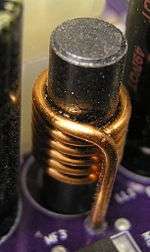Henry (unit)
| Henry | |
|---|---|
|
An inductor composed of a wire wound around a magnetic core used to confine and guide the induced magnetic field. | |
| Unit information | |
| Unit system | SI derived unit |
| Unit of | Inductance |
| Symbol | H |
| Named after | Joseph Henry |
| In SI base units: | kg⋅m2⋅s−2⋅A−2 |
The henry (symbol H) is the SI derived unit of electrical inductance.[1] The unit is named after Joseph Henry (1797–1878), the American scientist who discovered electromagnetic induction independently of and at about the same time as Michael Faraday (1791–1867) in England.[2] The magnetic permeability of vacuum is 4π×10−7 H m−1 (henry per metre).
The United States National Institute of Standards and Technology recommends English-speaking users of SI to write the plural as henries.[3]:31
Definition
The inductance of an electric circuit is one henry when an electric current that is changing at one ampere per second results in an electromotive force of one volt across the inductor :
- ,
where v(t) denotes the resulting voltage across the circuit, i(t) is the current through the circuit, and L is the inductance of the circuit.
The henry is a derived unit based on four of the seven base units of the International System of Units: kilogram (kg), meter (m), second (s), and ampere (A). Expressed in combinations of SI units, the henry is:[4]
where
Wb = weber,
T = tesla,
J = joule,
m = meter,
s = second,
A = ampere,
V = volt,
C = coulomb,
F = farad,
Hz = hertz,
Ω = ohm
As with every International System of Units (SI) unit named for a person, the first letter of its symbol is upper case (H). However, when an SI unit is spelled out in English, it should always begin with a lower case letter (henry)—except in a situation where any word in that position would be capitalized, such as at the beginning of a sentence or in material using title case. Note that "degree Celsius" conforms to this rule because the "d" is lowercase.— Based on The International System of Units , section 5.2.
See also
References
- ↑ Rowlett, Russ. "How Many? A Dictionary of Units of Measurement". University of North Carolina at Chapel Hill.
- ↑ Herbert S. Bailey, Jr. "A Princeton Companion".
- ↑ Ambler Thompson & Barry N. Taylor (2008). "NIST Special Publication 811: Guide for the Use of the International System of Units (SI)" (PDF). National Institute of Standards and Technology. Retrieved 2013-03-21.
- ↑ "Essentials of the SI: Base & derived units". The NIST Reference on Constants, Units and Uncertainty. National Institute of Standards and Technology.

